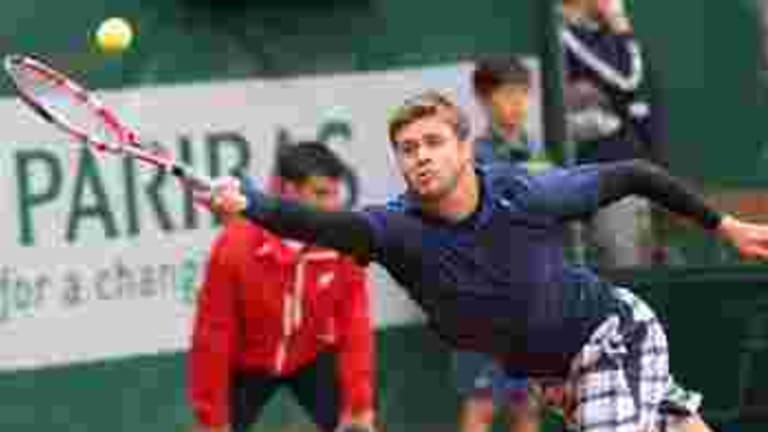Harrison looked over-matched from the start in a number of ways, starting with the nine inches of height he was giving way to his 6’9” countryman. Long John was dressed for the occasion in a signature, conservative Lacoste kit. Harrison, though, wore blue-gray plaid shorts (the Parisians just love it when Americans come to town!) and a long-sleeved black jersey under his navy blue tennis shirt. His invitation obviously read “Come as you are. . .” And he did.
But he soon had bigger things to worry about, as Isner began to unload those flat and kick serves that leave marks that sometimes look more like craters in the soft red clay. Isner had a couple of break points in the fourth game but failed to convert; Harrison then allowed Isner to escape from a 0-40 hole in the next game, and then all went calm for a spell. But at 5-all, Harrison played a magical point—how else can you describe a successful lob over Isner’s head?—to break, and he then served out the first set.
In the second set, we wandered into the horse latitudes that are prominently marked on the chart of any Isner match. This is a guy who specializes in playing short points but long matches. Because of how well Isner serves, and how ineffectively he sometimes returns, your eyes can glaze over and you might even doze off a bit as the games slip by, no break point interrupting the empty horizon. The only solution for these Isner-ish standoffs is the tiebreaker.
We had one of those shootouts in the second set, and it was well played by both men, with no mini-breaks until the eighth point, when Harrison tagged a pretty, down-the-line backhand passing shot. Although he failed to consolidate that advantage, he went on to take the tiebreaker with an inside-out forehand winner, 9-7.
The lead was two sets to none, but Isner is a little like one of those old Spanish galleons. It takes an awful long time to turn him around, but once it’s done and he’s headed in the right direction, watch out! He broke a racquet in frustration early in the third set, but it was just a moment of pique rather than a gesture of surrender. Still, it was surprising to hit the lone turning point in the match just two games later.
At 1-2, Harrison played a weak game to fall behind love-40, and gave up the game when his backhand response to Isner’s service return fell wide. That was all Isner needed, although he broke again in the ninth game to seal the set.
“Whenever you’re up two sets like that,” Harrison would say later, “and the guy breaks a racquet and you’re starting to feel like you’re on top, it’s not a time to hit cruise control. It’s a time that you hit the gas pedal and try to bury them. I might have just gotten a little too relaxed on my service games because I hadn’t been broken yet, and I was feeling pretty comfortable in baseline rallies and definitely dictating.”
The dictating would come to a sudden end, pronto. Isner suddenly had the wind at his back. His serve always has snap, but now his forehand and backhands had sting, and he played some of the longest rallies I’ve ever seen him engaged in. When he didn’t win them, they still seemed to have the effect of making him feel he was in it. He broke Harrison early in the fourth and added another insurance break for 6-1. I’m not sure how many players have ever beaten Isner after giving up four breaks in two sets; I have a feeling it’s a low number.

